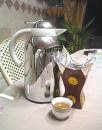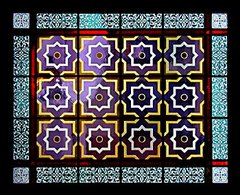

Eid Al Adha or Eid Al Kabeer (big Eid ) or Feast of sacrifice celebration or Korban in non Arabic Islamic cultures.
At the end of the Hajj (annual pilgrimage to Mecca), Muslims throughout the world celebrate the holiday of Eid al-Adha (Festival of Sacrifice). Eid Al Adha is four days in total a pre eid or pre celebration day called Youm Arafat when the pilgrims stand on mount Arafat in Saudi Arabia followed by three days of celebration and festivity.In 2009 based on the Islamic lunar calender Arafat day falls on 26 Nov. and the Eid days on 27th ,28, & 29 Nov. The dates move 10 to 12 days earlier each consecutive year.
During the Hajj, Muslims remember and commemorate the trials and triumphs of the Prophet Abraham. The Qur'an describes Abraham as follows:
"Surely Abraham was an example, obedient to Allah, by nature upright, and he was not of the polytheists. He was grateful for Our bounties. We chose him and guided him unto a right path. We gave him good in this world, and in the next he will most surely be among the righteous." (Qur'an 16:120-121)
One of Abraham's main trials was to face the command of Allah to kill his only son. Upon hearing this command, he prepared to submit to Allah's will. When he was all prepared to do it, Allah revealed to him that his "sacrifice" had already been fulfilled. He had shown that his love for his Lord superceded all others, that he would lay down his own life or the lives of those dear to him in order to submit to God.
During the celebration of Eid al-Adha, Muslims commemorate and remember Abraham's trials, by themselves slaughtering an animal such as a sheep. This action is very often misunderstood by those outside the faith.
Allah has given us power over animals and allowed us to eat meat, but only if we pronounce His name at the solemn act of taking life. Muslims slaughter animals in the same way throughout the year. By saying the name of Allah at the time of slaughter, we are reminded that life is sacred.
The meat from the sacrifice of Eid al-Adha is mostly given away to others. One-third is eaten by immediate family and relatives, one-third is given away to friends, and one-third is donated to the poor. The act symbolizes our willingness to give up things that are of benefit to us or close to our hearts, in order to follow Allah's commands. It also symbolizes our willingness to give up some of our own bounties, in order to strengthen ties of friendship and help those who are in need. We recognize that all blessings come from Allah, and we should open our hearts and share with others.
It is very important to understand that the sacrifice itself, as practiced by Muslims, has nothing to do with atoning for our sins or using the blood to wash ourselves from sin. This is a misunderstanding by those of previous generations: "It is not their meat nor their blood that reaches Allah; it is your piety that reaches Him." (Qur'an 22:37)
The symbolism is in the attitude - a willingness to make sacrifices in our lives in order to stay on the Straight Path. Each of us makes small sacrifices, giving up things that are fun or important to us. A true Muslim, one who submits his or herself completely to the Lord, is willing to follow Allah's commands completely and obediently. It is this strength of heart, purity in faith, and willing obedience that our Lord desires from us.
On the first morning of Eid al-Adha, Muslims around the world attend morning prayers at their local mosques. Prayers are followed by visits with family and friends, and the exchange of greetings and gifts. At some point, members of the family will visit a local farm or otherwise will make arrangements for the slaughter of an animal. The meat is distributed during the days of the holiday or shortly thereafter. In both Eids cards in all shapes and forms commemorating the festivity is sent/posted to relatives & friends and the pleasantry of Eid Mubarak or (Blessed Eid) is exchanged when greeting one another.
At the end of the Hajj (annual pilgrimage to Mecca), Muslims throughout the world celebrate the holiday of Eid al-Adha (Festival of Sacrifice). Eid Al Adha is four days in total a pre eid or pre celebration day called Youm Arafat when the pilgrims stand on mount Arafat in Saudi Arabia followed by three days of celebration and festivity.In 2009 based on the Islamic lunar calender Arafat day falls on 26 Nov. and the Eid days on 27th ,28, & 29 Nov. The dates move 10 to 12 days earlier each consecutive year.
During the Hajj, Muslims remember and commemorate the trials and triumphs of the Prophet Abraham. The Qur'an describes Abraham as follows:
"Surely Abraham was an example, obedient to Allah, by nature upright, and he was not of the polytheists. He was grateful for Our bounties. We chose him and guided him unto a right path. We gave him good in this world, and in the next he will most surely be among the righteous." (Qur'an 16:120-121)
One of Abraham's main trials was to face the command of Allah to kill his only son. Upon hearing this command, he prepared to submit to Allah's will. When he was all prepared to do it, Allah revealed to him that his "sacrifice" had already been fulfilled. He had shown that his love for his Lord superceded all others, that he would lay down his own life or the lives of those dear to him in order to submit to God.
During the celebration of Eid al-Adha, Muslims commemorate and remember Abraham's trials, by themselves slaughtering an animal such as a sheep. This action is very often misunderstood by those outside the faith.
Allah has given us power over animals and allowed us to eat meat, but only if we pronounce His name at the solemn act of taking life. Muslims slaughter animals in the same way throughout the year. By saying the name of Allah at the time of slaughter, we are reminded that life is sacred.
The meat from the sacrifice of Eid al-Adha is mostly given away to others. One-third is eaten by immediate family and relatives, one-third is given away to friends, and one-third is donated to the poor. The act symbolizes our willingness to give up things that are of benefit to us or close to our hearts, in order to follow Allah's commands. It also symbolizes our willingness to give up some of our own bounties, in order to strengthen ties of friendship and help those who are in need. We recognize that all blessings come from Allah, and we should open our hearts and share with others.
It is very important to understand that the sacrifice itself, as practiced by Muslims, has nothing to do with atoning for our sins or using the blood to wash ourselves from sin. This is a misunderstanding by those of previous generations: "It is not their meat nor their blood that reaches Allah; it is your piety that reaches Him." (Qur'an 22:37)
The symbolism is in the attitude - a willingness to make sacrifices in our lives in order to stay on the Straight Path. Each of us makes small sacrifices, giving up things that are fun or important to us. A true Muslim, one who submits his or herself completely to the Lord, is willing to follow Allah's commands completely and obediently. It is this strength of heart, purity in faith, and willing obedience that our Lord desires from us.
On the first morning of Eid al-Adha, Muslims around the world attend morning prayers at their local mosques. Prayers are followed by visits with family and friends, and the exchange of greetings and gifts. At some point, members of the family will visit a local farm or otherwise will make arrangements for the slaughter of an animal. The meat is distributed during the days of the holiday or shortly thereafter. In both Eids cards in all shapes and forms commemorating the festivity is sent/posted to relatives & friends and the pleasantry of Eid Mubarak or (Blessed Eid) is exchanged when greeting one another.


































